Citroen DS5 2014 1.G Owner's Manual
Manufacturer: CITROEN, Model Year: 2014, Model line: DS5, Model: Citroen DS5 2014 1.GPages: 372, PDF Size: 32.58 MB
Page 131 of 372

129Driving
The system is reactivated automatically
at every new start using the START/
STOP button.
Reactivation
Press the "ECO OFF"
switch again.
The system is active again; this is confirmed
by the switch warning lamp going off and a
message in the screen.
Operating fault
In the event of a fault with the system, the
"ECO OFF"
switch warning lamp flashes then
comes on continuously.
Have it checked by a CITROËN dealer or a
qualified workshop.
In the event of a fault in STOP mode, the vehicle
may stall.
All of the instrument panel warning lamps come
on.
Depending on version, an alert message may also
be displayed, asking you to place the gear lever in
position N
and put your foot on the brake pedal.
It is then necessary to switch off the ignition and
start the engine again using the "START/STOP"
button.
Before doing anything under the
bonnet, deactivate the Stop & Start
system to avoid any risk of injury
resulting from automatic operation of
START mode.
This system requires a 12 V battery with a
special specification and technology (reference
numbers available from CITROËN dealers).
Fitting a battery not listed by CITROËN
introduces the risk of malfunction of the
system.
For charging, use a 12 V charger and do not
reverse the polarity.
Maintenance
The Stop & Start system makes use of
advanced technology. For any work on
the system go to a qualified workshop
with the skills and equipment required,
which a CITROËN dealer is able to
provide.
Page 132 of 372
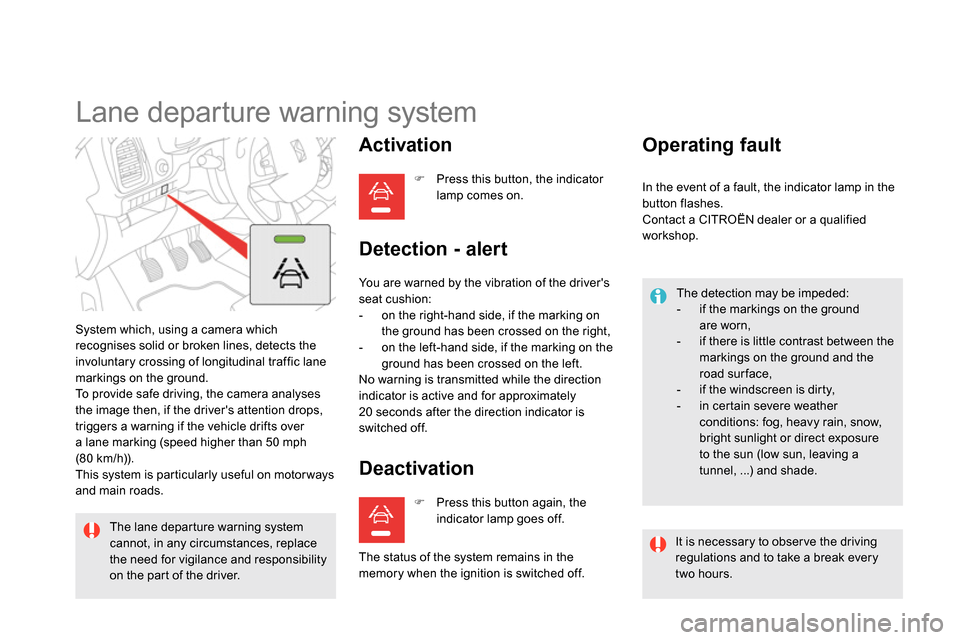
Lane departure warning system
System which, using a camera which
recognises solid or broken lines, detects the
involuntary crossing of longitudinal traffic lane
markings on the ground.
To provide safe driving, the camera analyses
the image then, if the driver's attention drops,
triggers a warning if the vehicle drifts over
a lane marking (speed higher than 50 mph
(80 km/h)).
This system is par ticularly useful on motor ways
and main roads.
Activation
Press this button, the indicator
lamp comes on.
The lane departure warning system
cannot, in any circumstances, replace
the need for vigilance and responsibility
on the part of the driver.
Deactivation
You are warned by the vibration of the driver's
seat cushion:
- on the right-hand side, if the marking on
the ground has been crossed on the right,
- on the left-hand side, if the marking on the
ground has been crossed on the left.
No warning is transmitted while the direction
indicator is active and for approximately
20 seconds after the direction indicator is
switched off.
Detection - alert
Operating fault
The detection may be impeded:
- if the markings on the ground
are worn,
- if there is little contrast between the
markings on the ground and the
road surface,
- if the windscreen is dirty,
- in certain severe weather
conditions: fog, heavy rain, snow,
bright sunlight or direct exposure
to the sun (low sun, leaving a
tunnel, ...) and shade.
Press this button again, the
indicator lamp goes off. In the event of a fault, the indicator lamp in the
button flashes.
Contact a CITROËN dealer or a qualified
workshop.
The status of the system remains in the
memory when the ignition is switched off.
It is necessary to obser ve the driving
regulations and to take a break every
two hours.
Page 133 of 372
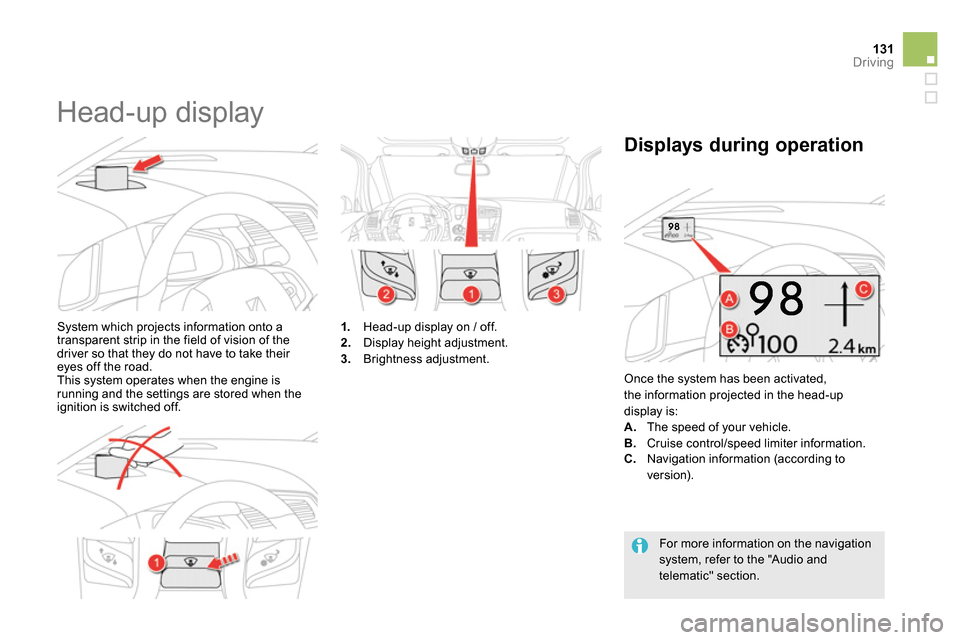
131Driving
Head-up display
System which projects information onto a
transparent strip in the field of vision of the
driver so that they do not have to take their
eyes off the road.
This system operates when the engine is
running and the settings are stored when the
ignition is switched off.
1.
Head-up display on / off.
2.
Display height adjustment.
3.
Brightness adjustment.
Once the system has been activated,
the information projected in the head-up
display is:
A.
The speed of your vehicle.
B.
Cruise control/speed limiter information.
Displays during operation
C.
Navigation information (according to
version).
For more information on the navigation
system, refer to the "Audio and
telematic" section.
Page 134 of 372
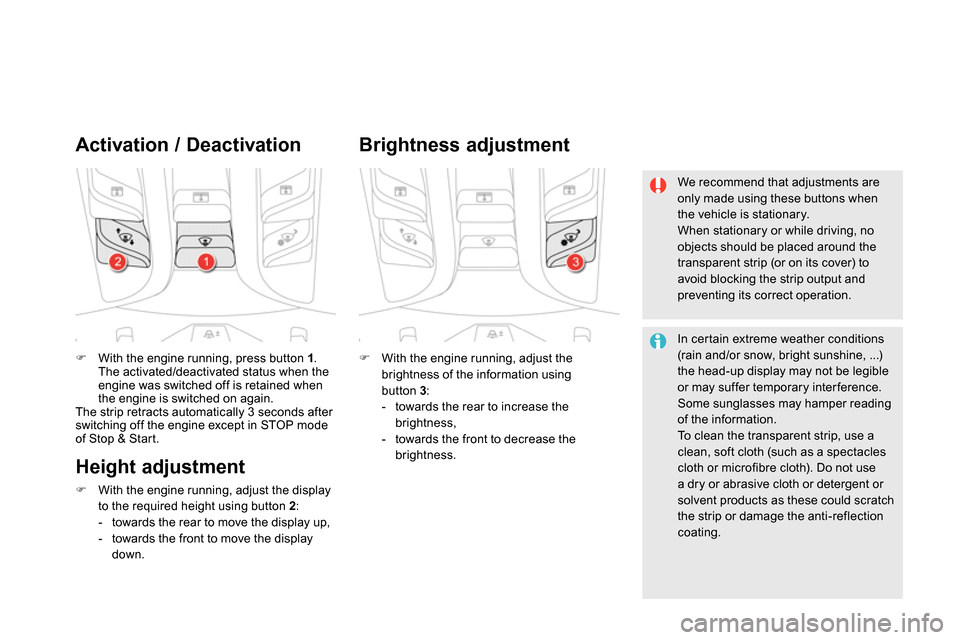
With the engine running, press button 1
.
The activated/deactivated status when the
engine was switched off is retained when
the engine is switched on again.
The strip retracts automatically 3 seconds after
switching off the engine except in STOP mode
of Stop & Start.
Activation / Deactivation
With the engine running, adjust the
brightness of the information using
button 3
:
- towards the rear to increase the
brightness,
- towards the front to decrease the
brightness.
Brightness adjustment
We recommend that adjustments are
only made using these buttons when
the vehicle is stationary.
When stationary or while driving, no
objects should be placed around the
transparent strip (or on its cover) to
avoid blocking the strip output and
preventing its correct operation.
In certain extreme weather conditions
(rain and/or snow, bright sunshine, ...)
the head-up display may not be legible
or may suffer temporary inter ference.
Some sunglasses may hamper reading
of the information.
To clean the transparent strip, use a
clean, soft cloth (such as a spectacles
cloth or microfibre cloth). Do not use
a dry or abrasive cloth or detergent or
solvent products as these could scratch
the strip or damage the anti-reflection
coating.
Height adjustment
With the engine running, adjust the display
to the required height using button 2
:
- towards the rear to move the display up,
- towards the front to move the display
down.
Page 135 of 372

133Driving
Memorising speeds
This memorising of speeds applies to both the speed limiter and the cruise control.
Select the "Personalisation-configuration"
menu and confirm.
Select " Vehicle parameters" menu and
confirm.
Select the "Driving assistance" line and
conform.
Select the "Speeds memorised" line and
confirm.
Modify the speed.
Select " OK
" and confirm to save the
modifications.
For safety reasons, the driver must only
carry out these operations using the
audio system screen when stationary.
You can memorise up to 5 speeds in the system.
By default, some speeds are already memorised.
Select the "Configuration" menu and
confirm.
Select the " Vehicle parameters" menu and
confirm.
Select the "Driving assistance" line and
confirm.
Select the "Speeds memorised" line and
confirm.
Modify the speed.
Select " OK
" and confirm to save the
modifications.
With the Audio System
With eMyWay
Go to the main menu by
pressing the "MENU"
button.
Go to the main menu by
pressing "SET UP"
.
Access
press the steering mounted "MEM"
button
to display the list of memorised speeds.
Selection
To select a memorised speed:
Press and hold the "+" or "-" button; the
system stops at the nearest memorised
speed.
Press and hold the "+" or "-" button again to
select another memorised speed.
A reminder of the speed and the state of the
system (active / inactive) is displayed in the
instrument panel.
Page 136 of 372
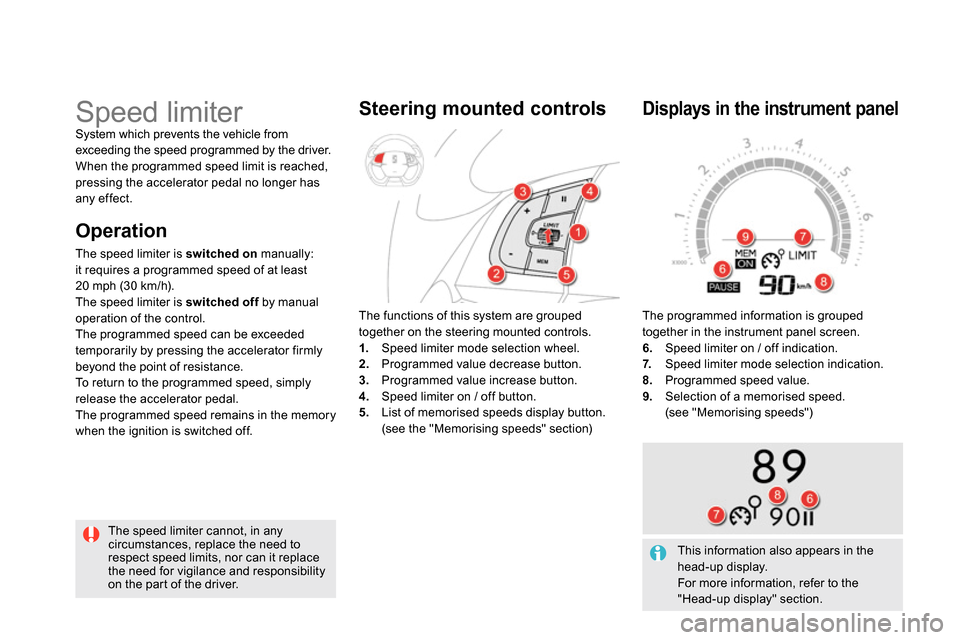
The programmed information is grouped
together in the instrument panel screen.
6.
Speed limiter on / off indication.
7.
Speed limiter mode selection indication.
8.
Programmed speed value.
9.
Selection of a memorised speed.
(see "Memorising speeds")
Displays in the instrument panel
Speed limiter
System which prevents the vehicle from
exceeding the speed programmed by the driver.
When the programmed speed limit is reached,
pressing the accelerator pedal no longer has
any effect.
The speed limiter cannot, in any
circumstances, replace the need to
respect speed limits, nor can it replace
the need for vigilance and responsibility
on the part of the driver. The functions of this system are grouped
together on the steering mounted controls.
1.
Speed limiter mode selection wheel.
2.
Programmed value decrease button.
3.
Programmed value increase button.
4.
Speed limiter on / off button.
5.
List of memorised speeds display button.
(see the "Memorising speeds" section)
Steering mounted controls
Operation
The speed limiter is switched on
manually:
it requires a programmed speed of at least
20 mph (30 km/h).
The speed limiter is switched off
by manual
operation of the control.
The programmed speed can be exceeded
temporarily by pressing the accelerator firmly
beyond the point of resistance.
To return to the programmed speed, simply
release the accelerator pedal.
The programmed speed remains in the memory
when the ignition is switched off.
This information also appears in the
head-up display.
For more information, refer to the
"Head-up display" section.
Page 137 of 372
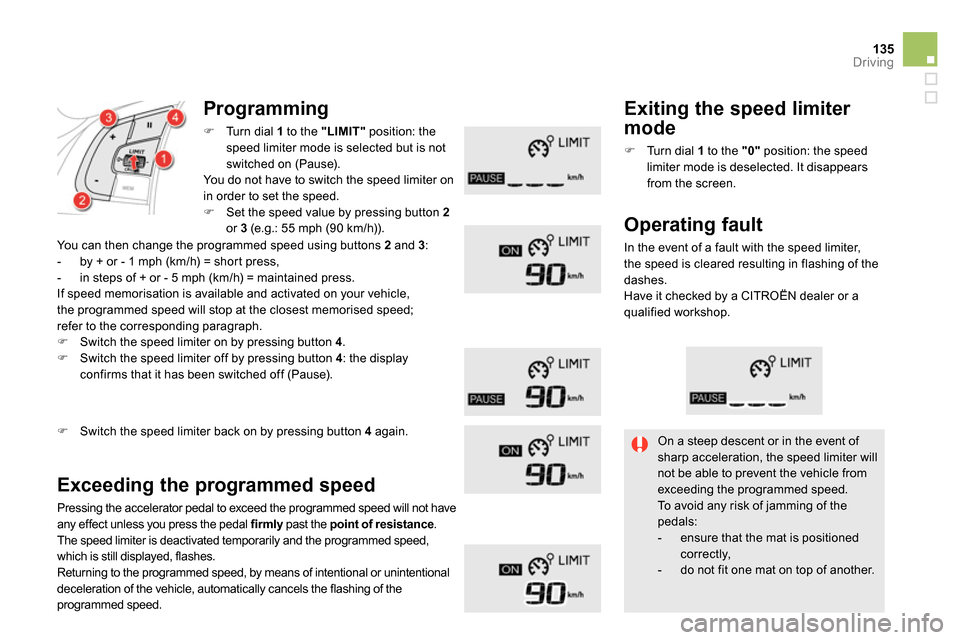
135Driving
Programming
Turn dial 1
to the "LIMIT"
position: the
speed limiter mode is selected but is not
switched on (Pause).
You do not have to switch the speed limiter on
in order to set the speed.
Set the speed value by pressing button 2
or 3
(e.g.: 55 mph (90 km/h)).
Exceeding the programmed speed
Pressing the accelerator pedal to exceed the programmed speed will not have
any effect unless you press the pedal firmly
past the point of resistance
.
The speed limiter is deactivated temporarily and the programmed speed,
which is still displayed, flashes.
Returning to the programmed speed, by means of intentional or unintentional
deceleration of the vehicle, automatically cancels the flashing of the
programmed speed.
Exiting the speed limiter
mode
Turn dial 1
to the "0"
position: the speed
limiter mode is deselected. It disappears
from the screen.
Operating fault
In the event of a fault with the speed limiter,
the speed is cleared resulting in flashing of the
dashes.
Have it checked by a CITROËN dealer or a
qualified workshop.
On a steep descent or in the event of
sharp acceleration, the speed limiter will
not be able to prevent the vehicle from
exceeding the programmed speed.
To avoid any risk of jamming of the
pedals:
- ensure that the mat is positioned
correctly,
- do not fit one mat on top of another.
Switch the speed limiter back on by pressing button 4
again.
You can then change the programmed speed using buttons 2
and 3
:
- by + or - 1 mph (km/h) = short press,
- in steps of + or - 5 mph (km/h) = maintained press.
If speed memorisation is available and activated on your vehicle,
the programmed speed will stop at the closest memorised speed;
refer to the corresponding paragraph.
Switch the speed limiter on by pressing button 4
.
Switch the speed limiter off by pressing button 4
: the display
confirms that it has been switched off (Pause).
Page 138 of 372
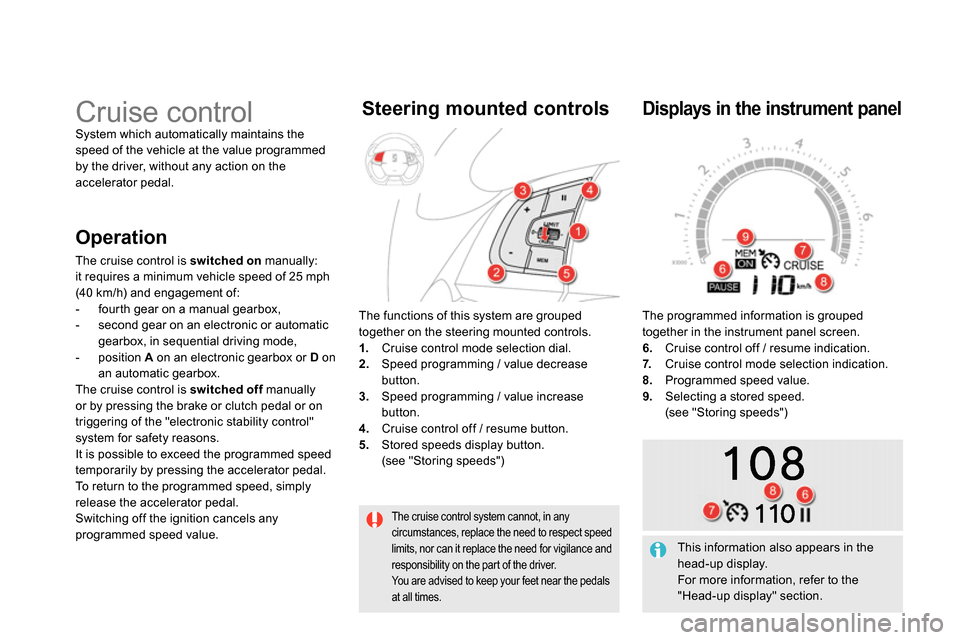
The cruise control system cannot, in any
circumstances, replace the need to respect speed
limits, nor can it replace the need for vigilance and
responsibility on the part of the driver.
You are advised to keep your feet near the pedals
at all times.
Cruise control
System which automatically maintains the
speed of the vehicle at the value programmed
by the driver, without any action on the
accelerator pedal.
The functions of this system are grouped
together on the steering mounted controls.
1.
Cruise control mode selection dial.
2.
Speed programming / value decrease
button.
3.
Speed programming / value increase
button.
4.
Cruise control off / resume button.
5.
Stored speeds display button.
(see "Storing speeds")
Steering mounted controls
The programmed information is grouped
together in the instrument panel screen.
6.
Cruise control off / resume indication.
7.
Cruise control mode selection indication.
8.
Programmed speed value.
9.
Selecting a stored speed.
(see "Storing speeds")
Displays in the instrument panel
Operation
The cruise control is switched on
manually:
it requires a minimum vehicle speed of 25 mph
(40 km/h) and engagement of:
- fourth gear on a manual gearbox,
- second gear on an electronic or automatic
gearbox, in sequential driving mode,
- position A
on an electronic gearbox or D
on
an automatic gearbox.
The cruise control is switched off
manually
or by pressing the brake or clutch pedal or on
triggering of the "electronic stability control"
system for safety reasons.
It is possible to exceed the programmed speed
temporarily by pressing the accelerator pedal.
To return to the programmed speed, simply
release the accelerator pedal.
Switching off the ignition cancels any
programmed speed value.
This information also appears in the
head-up display.
For more information, refer to the
"Head-up display" section.
Page 139 of 372
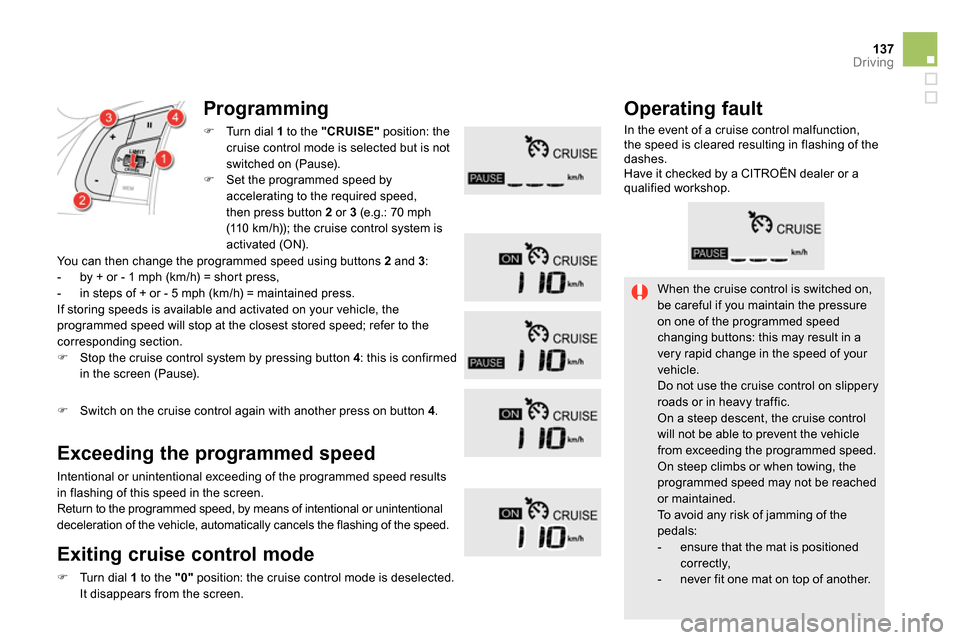
137Driving
When the cruise control is switched on,
be careful if you maintain the pressure
on one of the programmed speed
changing buttons: this may result in a
very rapid change in the speed of your
vehicle.
Do not use the cruise control on slippery
roads or in heavy traffic.
On a steep descent, the cruise control
will not be able to prevent the vehicle
from exceeding the programmed speed.
On steep climbs or when towing, the
programmed speed may not be reached
or maintained.
To avoid any risk of jamming of the
pedals:
- ensure that the mat is positioned
correctly,
- never fit one mat on top of another.
Programming
Turn dial 1
to the "CRUISE"
position: the
cruise control mode is selected but is not
switched on (Pause).
Set the programmed speed by
accelerating to the required speed,
then press button 2
or 3
(e.g.: 70 mph
(110 km/h)); the cruise control system is
activated (ON).
Exceeding the programmed speed
Intentional or unintentional exceeding of the programmed speed results
in flashing of this speed in the screen.
Return to the programmed speed, by means of intentional or unintentional
deceleration of the vehicle, automatically cancels the flashing of the speed.
Exiting cruise control mode
Turn dial 1
to the "0"
position: the cruise control mode is deselected.
It disappears from the screen.
Switch on the cruise control again with another press on button 4
.
Operating fault
In the event of a cruise control malfunction,
the speed is cleared resulting in flashing of the
dashes.
Have it checked by a CITROËN dealer or a
qualified workshop.
You can then change the programmed speed using buttons 2
and 3
:
- by + or - 1 mph (km/h) = short press,
- in steps of + or - 5 mph (km/h) = maintained press.
If storing speeds is available and activated on your vehicle, the
programmed speed will stop at the closest stored speed; refer to the
corresponding section.
Stop the cruise control system by pressing button 4
: this is confirmed
in the screen (Pause).
Page 140 of 372
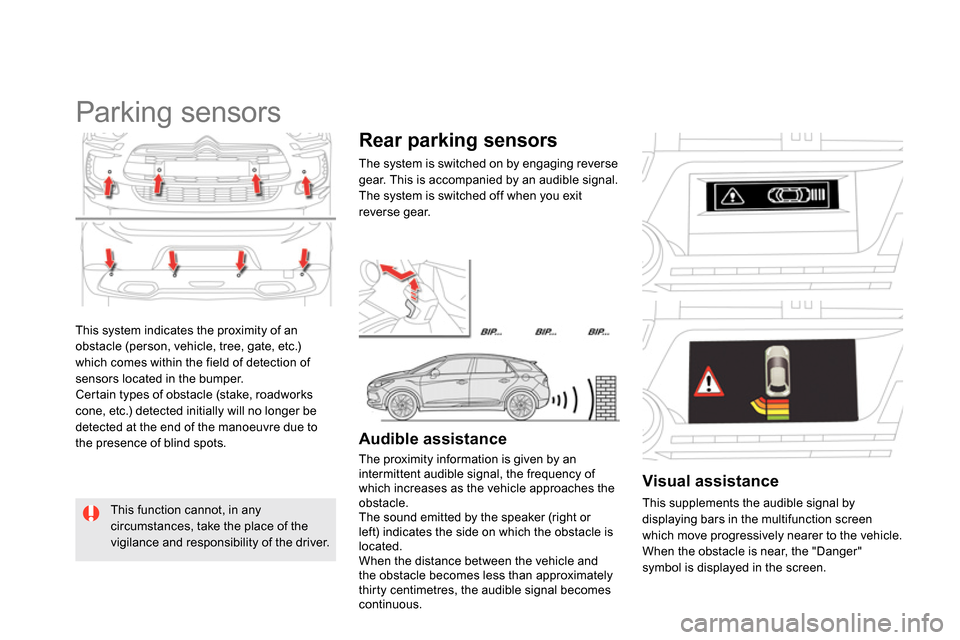
This system indicates the proximity of an
obstacle (person, vehicle, tree, gate, etc.)
which comes within the field of detection of
sensors located in the bumper.
Certain types of obstacle (stake, roadworks
cone, etc.) detected initially will no longer be
detected at the end of the manoeuvre due to
the presence of blind spots.
Parking sensors
This function cannot, in any
circumstances, take the place of the
vigilance and responsibility of the driver.
Rear parking sensors
The system is switched on by engaging reverse
gear. This is accompanied by an audible signal.
The system is switched off when you exit
reverse gear.
Audible assistance
The proximity information is given by an
intermittent audible signal, the frequency of
which increases as the vehicle approaches the
obstacle.
The sound emitted by the speaker (right or
left) indicates the side on which the obstacle is
located.
When the distance between the vehicle and
the obstacle becomes less than approximately
thirty centimetres, the audible signal becomes
continuous.
Visual assistance
This supplements the audible signal by
displaying bars in the multifunction screen
which move progressively nearer to the vehicle.
When the obstacle is near, the "Danger"
symbol is displayed in the screen.